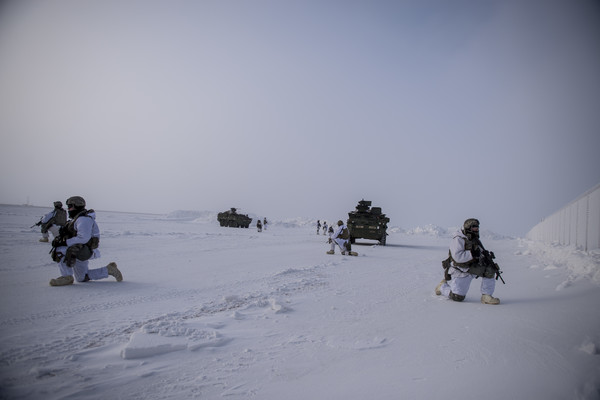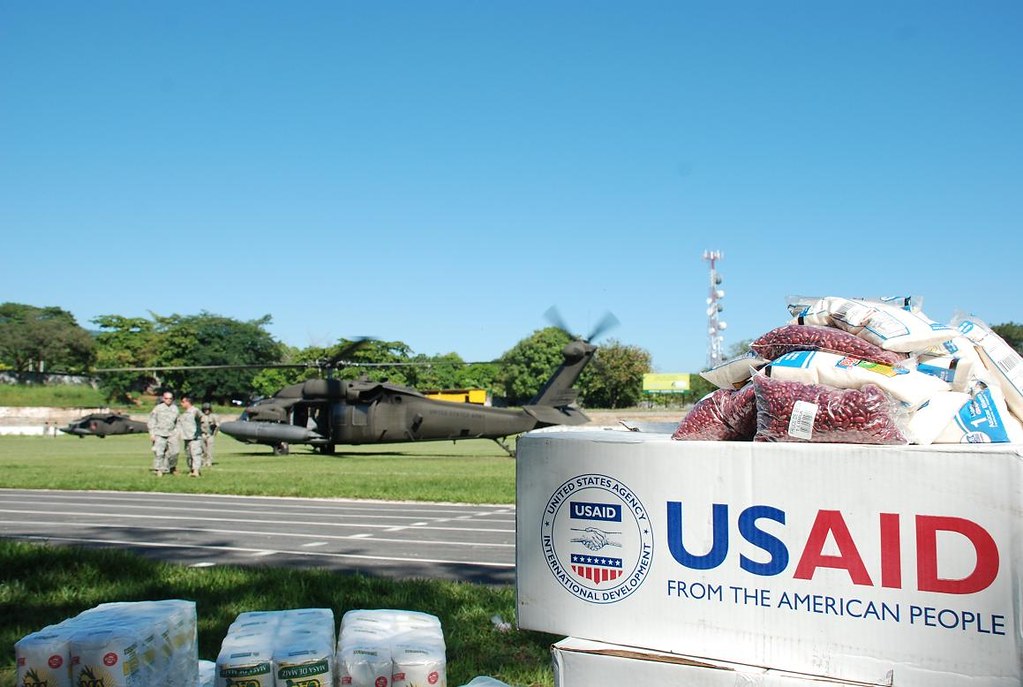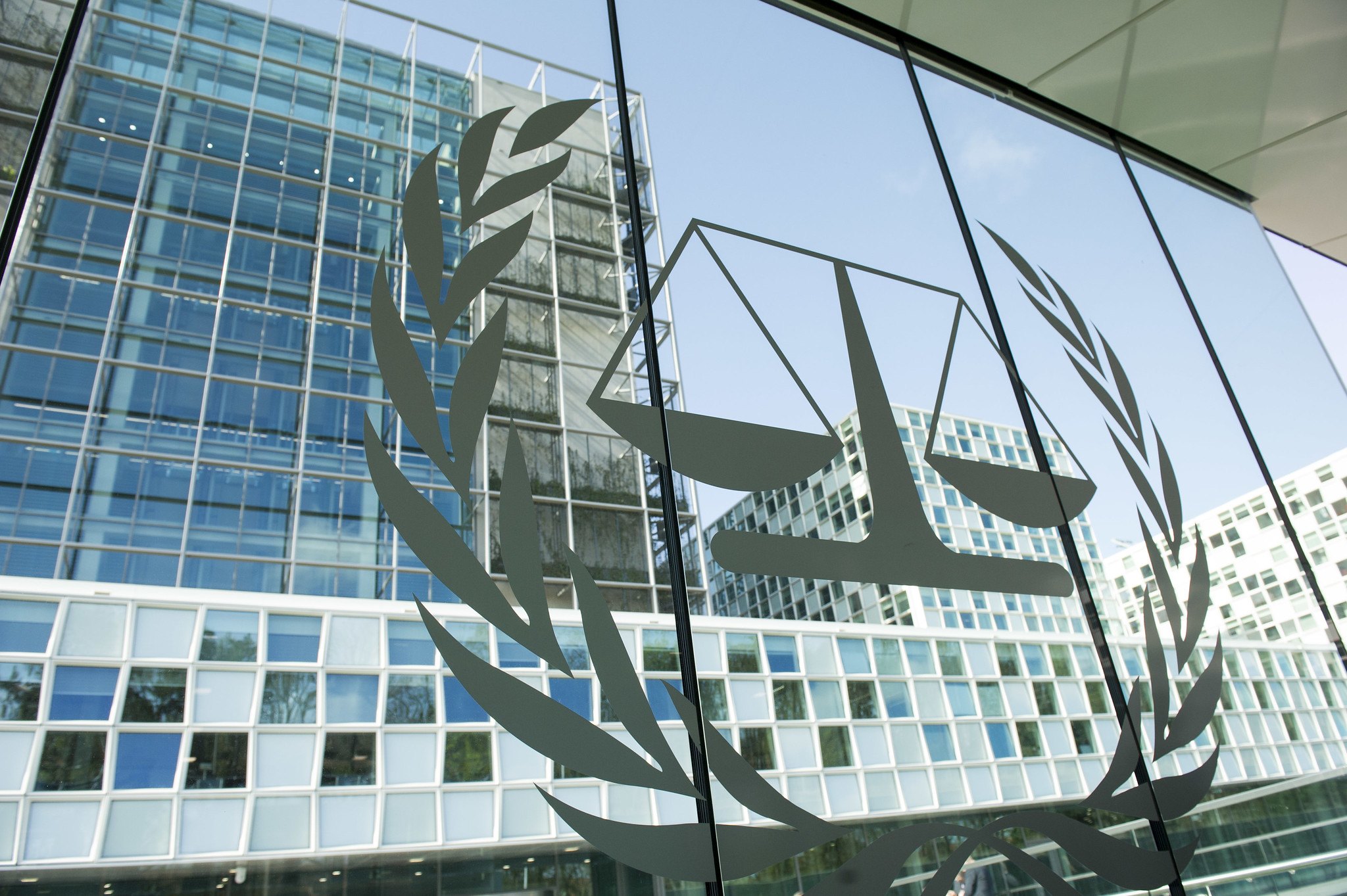Arctic Provisions in the 2020 NDAA
The draft National Defense Authorization Act (NDAA) for fiscal year 2020, currently in conference, includes three Arctic-specific provisions that show a continuing increase in congressional attention to the Arctic over the past five years.

Published by The Lawfare Institute
in Cooperation With

In September, the U.S. Navy, Marine Corps and Coast Guard completed the Arctic Expeditionary Capabilities Exercise (AECE). The AECE brought approximately 3,000 Marines and sailors to the Aleutian Islands and Southcentral Alaska, where they tested and refined their ability to operate in the extreme-weather environment of the Arctic. Specifically, the troops rehearsed deploying wet logistics, mine countermeasures, mobile diving and salvage, and petroleum transport.
The AECE is part of an expansion of U.S. (and NATO) military activities in the Arctic. It comes close on the heels of two exercises in Norway: the March 2019 Marine Corps rotation and NATO’s 4,000-soldier-strong Trident Juncture exercise in fall 2018. The Marines have maintained a rotation with the Norwegians for several years, but the March 2019 iteration more than doubled the number of participating troops, from around 330 to 700. Moreover, Trident Juncture was the largest NATO exercise in more than 16 years. The AECE was itself the first major “winter amphibious” operation in Alaska since 1987.
These Arctic-based exercises come at a time of growing U.S. military interest in the Arctic region. The draft National Defense Authorization Act (NDAA) for fiscal year 2020, currently in conference, includes three Arctic-specific provisions. Read in the context of past NDAAs, the three provisions show a continuing increase in congressional attention to the Arctic over the past five years. Additionally, two of the draft provisions highlight Congress’s growing interest in China’s Arctic activity and in ensuring operability of U.S. forces in the Arctic in light of Russian and Chinese activity in the region. This post puts those provisions in context. It first describes the state of affairs relating to U.S. military interest in the Arctic. It then details the significance of two of the Arctic-related provisions in the draft 2020 NDAA.
U.S. Military Interests in the Arctic: Russia, the Economy and China
Over the past five years, the Arctic has increased in national strategic importance to the U.S. military in two ways. First, Russia is a growing national security threat. Second, a flurry of new economic interests has invited attention from the circumpolar countries, including the U.S. Third, China has sought to extend its geopolitical influence into the Arctic through economic development, necessitating an American response.
Russia’s Arctic presence poses a national security threat to the United States of a severity unseen since the end of the Cold War. The Russian threat is elevated by a build-up of Russian military activity and higher tensions between the United States and Russia. The Soviet military once operated extensively along its 15,000-mile Arctic coastline. Its Northern Fleet was headquartered at Murmansk on the Kola Peninsula, where it maintained a majority of its ballistic missile submarines. Furthermore, it operated more than 26 Arctic bases by 1990. After the fall of the Soviet Union, Russia shuttered the majority of Arctic operations, and military activity in the region dropped considerably.. The assertive foreign policy of Russian President Vladimir Putin reversed this trend. He has presided over the reopening of some of Russia’s most far-flung military outposts, including 14 new airfields and 16 deepwater ports along its northern coast. Global warming has made these operations cheaper and more feasible, as ice that previously posed obstacles to movement has melted away for part or all of the year.
Alongside this military activity, the Russian administration has made clear that it will defend and expand its territorial possessions in the region to its utmost ability. Pursuant to the U.N. Convention on the Law of the Sea, it has made several submissions laying claim to portions of the Arctic. It has continued to gather evidence to bolster this claim, even up to the present. It symbolically did so in 2007 by planting the Russian tricolor on the Arctic seabed during an expedition of the Arktika submarine. Several of Russia’s territorial claims compete with Canadian and Danish claims. It also signed in 2010 a treaty with Norway ending a 40-year border dispute in the Barents Sea. None of these territorial issues has bubbled over into armed conflict. Nevertheless, they demonstrate Russia’s abiding commitment to maintaining control of its Arctic territorial claims. The competition for territory represents a security threat to the United States not only because of its own territorial possessions in the Arctic but also because its treaty obligations require it to come to the aid of Canada, Norway and Denmark if they become the target of Russian aggression. This security threat was recognized in the 2019 NDAA, which articulated (in § 1248) the U.S.’s commitment to countering Russian aggression throughout Europe, including in the Arctic.
Growing tensions between the United States and Russia have also increased the possibility of a military skirmish in the Arctic. These tensions have grown as a result of many factors, chief among which are interference in the 2016 election, the 2014 invasion and annexation of Crimea, and the ongoing violation of the territorial integrity of Ukraine’s eastern provinces. While these tensions do not stem from the Arctic itself, the region may well become an arena for conflict. Indeed, if one country were to seek proportional retaliation for aggression, it might well choose an isolated target like those in the Arctic, where the risks of escalation are lower than in more populated areas.
Complementing these national security concerns are an explosion of economic interests in the Arctic, which have grown in prominence due chiefly to landscape shifts caused by climate change. The Arctic is home to sizable deposits of natural resources in the seabed and under Greenland’s ice caps. As melting ice has made these deposits more accessible, the Arctic circumpolar nations have begun a race to solidify their claims to the territory under which the deposits are located. Increased navigability has also led to more shipping and cruise-line traffic through the Arctic. These economic developments require the attention of the U.S. military not only to defend against other countries’ militaries but also because the military is largely the only entity capable of disaster response in the region, given the lack of large-scale nonmilitary infrastructure.
Finally, despite not being an Arctic nation itself, China has begun to turn its geopolitical attention to the Arctic through economic development. China’s ambitions have been growing for some time. In 2013, China achieved observer status at the Arctic Council after years of diplomatic maneuvering to do so. It has also targeted investment at Arctic countries for years, concluding a 2016 deal to invest in the Kvanefjeld mineral extraction project in Greenland and agreeing to finance several projects in Iceland following the 2008 economic collapse. In January 2018, China released a white paper detailing its Arctic policy, particularly the Polar Silk Road initiative. The Polar Silk Road seeks to extend China’s program of influence through economic development along the newly opened and opening shipping routes in the Arctic.
The 2020 NDAA Provisions
Before the 2014 NDAA, the term “Arctic” appeared in only two NDAAs, neither of which framed American interests in the region in national security terms. The first was the 2001 NDAA, which permitted the secretary of energy to establish an Arctic Energy Department. The second was the 2004 NDAA, which mandated a review of the Arctic Military Environmental Cooperation (AMEC) Program. AMEC was a cooperative venture among the militaries of the United States, Canada, Norway and Russia that was chiefly concerned with disposal of toxic materials in the Arctic region. Outside these narrow directives regarding the environment and energy, the pre-2014 NDAAs took no notice of the Arctic.
The Arctic made its NDAA debut in the 2014 law and has since steadily grown in prominence. Between 2014 and 2019, the NDAAs contained 12 provisions that mentioned the Arctic. Of these, five provisions were focused primarily on the Arctic in some way and related directly to national security. For example, two Arctic-specific provisions in the 2018 law required reports on Department of Defense and Navy capabilities in the Arctic. Additionally, the 2019 law required a report from the Department of Defense on Arctic strategy, which was published in June. The remaining seven provisions made only a passing reference to the Arctic. Such provisions include requirements in 2016 and 2019 that the Department of Defense monitor Russia’s Arctic activities closely, and 2015 and 2017 orders that the department assess Indo-Pacific actors’ ambitions in the Arctic. Notably, all of the NDAAs since 2016 have described Russia’s military resurgence as a particular threat in the Arctic.
As of this post’s publication, the draft 2020 NDAA remains subject to change in conference committee. Each chamber’s approved preconference bill (H.R. 2500 and S. 1790), however, contains the same three Arctic-specific provisions. On the whole, the draft 2020 NDAA is notable for including those three provisions that are dedicated solely to the Arctic region, an all-time high. More specifically, two of three provisions are notable in their own right. The third only reiterates a similar provision in the 2017 NDAA.
First, the provision requiring a report on Chinese foreign direct investment in the Arctic marks the first time Congress has recognized that China’s growing global influence has extended into the Arctic, and that the United States needs to counter that influence. Second, the provision on cold-weather training is among the first provisions to operationalize the military’s interest in the Arctic.
Section 1250J: Chinese Foreign Direct Investment in Countries of the Arctic Region
Section 1250J of the draft 2020 NDAA directs the secretary of defense to commission an independent report on Chinese foreign direct investment in countries of the Arctic region. The report must contain details on Chinese-funded projects in the United States, Russia, Canada, Greenland, Norway and Iceland. It must further compare these projects to other investor-states’ projects, including those funded by India, Japan, South Korea, the Netherlands and France. The report must also take note of how China’s foreign direct investment fits into its strategic objectives in the Arctic generally. This provision builds on § 1261 of the 2019 NDAA, which required the president to submit a whole-of-government strategy to deal with China’s global ambitions, including the Arctic.
Section 1250J is remarkable because it is the first NDAA provision aimed solely at China’s ambitions in the Arctic. It demonstrates that Congress has taken notice of the Polar Silk Road and perhaps intends to counter it down the line. The provision comes at a time of growing bipartisan skepticism of China’s policy of extending influence through economic investment, as it has done throughout developing countries in Africa. That the United States itself possesses territorial interests in the Arctic, unlike in Africa, heightens the sense of urgency to respond to China’s policy.
Section 1080D: Plan to Increase and Expand Cold-Weather Training
Section 1080D of the draft 2020 NDAA requires that the secretary of the Army prepare a plan for cold-weather training. It recognizes that the operability of U.S. forces in cold weather has atrophied in relation to its adversaries, specifically naming the Russian build-up of Arctic forces as a threat. The plan prepared by the secretary of the Army must account for the military’s current preparedness to operate in the extreme cold and the scenarios that might require it to do so. As mentioned in the introduction, the U.S. military has undertaken various cold-weather exercises in the past five years. This provision indicates Congress’s intention that those exercises increase in frequency and scope.
Section 1080D is unique because it is the first-ever NDAA provision to require a plan for tactical operations in the Arctic. All 12 of the Arctic-related provisions in NDAAs since 2014 have required high-level strategic analysis. For example, previous NDAAs have commissioned reports on the ambitions of Asia-Pacific actors in the Arctic, on the Department of Defense’s Arctic capabilities writ large, and on Russian military operations worldwide, including in the Arctic. These reports did not necessarily foresee Arctic conflict but, rather, directed the military to remain abreast of developments in the region. In contrast, Section 1080D indicates that Congress, for the first time, has contemplated conflict taking place in the Arctic. While the Department of Defense has conducted exercises of this type of its own accord, it is significant that Congress has now noted the importance of those exercises.
Looking Ahead
The conferees for the draft 2020 NDAA entered negotiations on Sept. 19. Chairs Sen. Jim Inhofe and Rep. Adam Smith hope to send the bill back to their respective chambers by the end of October, though the number of thorny issues remaining to be resolved may put that deadline in jeopardy.
Beyond this NDAA, it is fair to expect continued and growing U.S. congressional attention to the Arctic. The forces leading to this current situation—a resurgent Russia, an ascendant China and rapid climate change eroding Arctic ice—do not appear poised to diminish in the coming years. An additional area to watch will be how Congress responds to the frenetic attention the European Union has paid to the Arctic during the past decade, especially because of recent divergence on security and economic issues between the U.S. and the EU.





